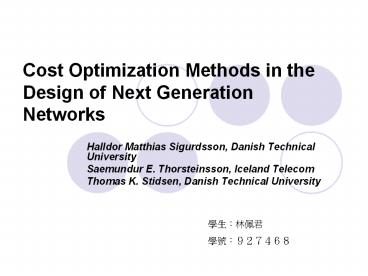Cost Optimization Methods in the Design of Next Generation Networks
1 / 14
Title:
Cost Optimization Methods in the Design of Next Generation Networks
Description:
Cost Optimization Methods in the Design of Next Generation Networks Halldor Matthias Sigurdsson, Danish Technical University Saemundur E. Thorsteinsson, Iceland Telecom –
Number of Views:92
Avg rating:3.0/5.0
Title: Cost Optimization Methods in the Design of Next Generation Networks
1
Cost Optimization Methods in the Design of Next
Generation Networks
- Halldor Matthias Sigurdsson, Danish Technical
University - Saemundur E. Thorsteinsson, Iceland Telecom
- Thomas K. Stidsen, Danish Technical University
????? ??927468
2
Outline
- INTRODUCTION
- PSTN (Public Switched Telephone Network)
- NGN (Next-Generation Network)
- MIGRATION PLAN
- THE TOTAL COST OF OWNERSHIP)
- MATHEMATICAL MODELING
- IMPLEMENTING THE MODEL
- OPTIMIZING THE MODEL
- CONCLUSION
3
PSTNIceland Telecoms PSTN
- LEs Local exchanges
- TEs Transit exchanges
- RSS remote subscriber
- stage
- Users are connected with a pair of copper wires
(local loop) to the closest RSS. - 10 LEs PSTN that all connect to twoTEs
4
PSTN-connectivity and topology map for circuit
switched network
- LTLs local trunk lines
- connect RSSs to LEs
- TTLstransit trunk lines
- connect LEs to TEs
5
NGN-principle parts(1)
- Telephony Sever(TSs)
- handle call and service control in the new
system. - In the migration plan, the two current TEs will
be upgraded to TSs. - Media Gateway(MGWs)
- core switches in the new IP or ATM backbone
network. - In the migration plan, an optimal number of LEs
will be upgraded to MGWs. - Access Ramps(ARs)
- termination points of the local loop.
- provide customers with both narrowband and
broadband connectivity. - In the first step of the migration plan, the
current 210 RSSs will be kept unchanged.
6
NGN-principle parts(2)
- Connectivity Network
- a backbone IP or ATM network between MGWs.
- built on leased slots between
- nodes in the existing SDH fiber network.
- In the migration plan,
- MGWs can be located wherever there is an SDH
node. - will be connected to the TSs with SDH slots of
the required bandwidth.
7
Migration Plan
- Base on upgrading existing
- TEs to TSs
- LEs to MGWs
- connect them all using an ATM or IP connectivity
network. - The Problem
- find the position and number of MGWs that
minimize the TCO of the NGN network.
8
The Total Cost of Ownership (1)
- cost factors
- Leased line cost ,Depreciation ,Interest, Housing
and internal services - By simulating these five cost factors in a
mathematical model for both the current and
future networks. - Minimizing
- exists an optimal number and position of MGWs
9
The Total Cost of Ownership (2)
- Reason Of Minimizing
- Step 1
- If the position of MGWs for each number of MGWs
is - optimized, a function of minimum total leased
line cost relative to the number of MGWs can be
found.
10
The Total Cost of Ownership (3)
- Reason Of Minimizing
- Step 2
- As the number of MGWs increases, these cost
factors start increasing more rapidly than is
saved in local leased - line cost.
- At that point, the total cost is at a minimum.
11
MATHEMATICAL MODELING
- bandwidth requirements
- can be estimated based on empirical data and a
statistical multiplexing factor. - Distance matrix
- represents the shortest distance between any two
nodes in the network - can be populated using available operations
research solutions of the shortest path problem, - TCO( total cost of ownership)
- The TCO becomes the objective function in the
optimization - can be expressed as total leased line cost plus
the sum over other cost - components.
12
IMPLEMENTING THE MODEL
- Spreadsheet program
- Availability ,flexibility, and ease of use gives
them strong appeal. - an easy-to-use graphical user interface
- can get the estimated total cost of ownership
for the future NGN - examine the financial effect of combining
structural changes with the migration.
13
OPTIMIZING THE MODEL
- Requires a third party solver addin.
- By combining intuition and heuristics,
- accurate approximations to the global optimum
can be reached. - GAMS (General Algebraic Modeling System)
- Ensure a global optimum
- The optimization produces
- a network structure with the lowest possible
total cost of ownership. - the model can also indicate how deviations from
the optimum affect cost.
14
CONCLUSION
- 19 percent reduction in TCO can be achieved by
changing the structure to three MGWs instead of
upgrading all 10 LEs in the current
circuit-switched configuration. - The feasibility of NGN can be assessed by
comparing the cost of NGN migration to that of
maintaining the current circuitswitched network.































